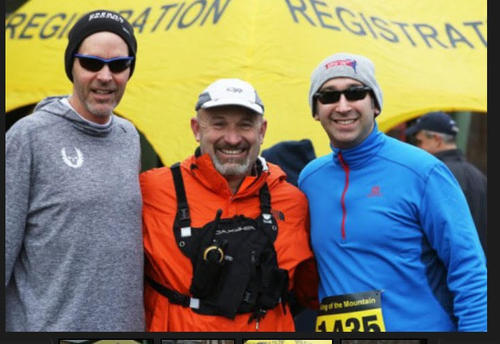Left to right— Jeff Benjamin, Race Director Matt Lebow, and Michael Schnall, NYRR’s Vice President for Community Engagement Initiatives.(Photo Courtesy of King of the Mountain Events)
This is a piece that Jeff Benajmin wrote for us on the quandaries of chip timing. It is a good and thoughtful read.
Chip Timing vs Gun Time – A Never Ending Debate?By Jeff Benjamin
Flashback to 1982–
It was a warm day at the NYC Marathon. In a thrilling battle, 2-time NYC Champion and World Record holder Alberto Salazar dukes it out with Mexico’s Rudolfo Gomez. Just before the 26 mile Mark Salazar makes his move by putting on a driving surge with a little more than 400 meters through a dusty patch to beat Gomez and win his 3rd NYC race in a row with a time of 2 hours 9 minutes 29 seconds. Greta Waitz of Norway would later go on to win her 4th NY Marathon (2:27:14) en route to eventually finishing her career with 9 New York wins!Back in the pack of the mass of runners, my friend Ken Christensen, a senior in high school, was racing along hoping to get his goal of breaking the 3-hour barrier. Running 30:51 for 5 miles, then around 1 hour 19 minutes through the halfway mark, my unorthodox pal (who raced at Van Cortland Park just the day before over the infamous 2 1/2 mile XC course!) hit the “Wall” at 20 miles and struggled home to the finish with the time of 3 hours 2 minutes and 50 seconds.
After his performance one of his friends who saw him at the start told him that he easily lost around 4 minutes by wading through the crowd just to get to the starting line.Fast Forward to the present!
At last weekends’ Resolution Trail Run 5K here on Staten Island, King of the Mountain Race Director Matt Lebow (No relation to the late great impresario) was faced with a perplexing problem. The 2nd place Woman’s chip time was a few seconds faster than the first place woman which begged the question–who is the champion?!
After consulting with USATF NY Vice President John Padula, who looked over the USATF rules, it was determined that the woman who crossed the line first was the winner. But in a gesture of goodwill Lebow also presented the 2nd place woman with a “Best Time” award.The events that occurred brought up a healthy discussion with some of the sports’ top movers and shakers. With the quick rise of the chip timing technology in races both large and small, how are the rules set up? While everyone in the world of Track and Field is beholden to recording as accurate a time as possible using the best technology, Road Racing, let’s just say, comes with many variables. To quote legendary Mile great (and later on road race media correspondent) Marty Liquori, “Track is Carnegie Hall while Road Racing is Rock n Roll”
For example what would have happened if, at last months’ LA Olympic marathon trials, one of our elite runners tripped before the starting line, finished in the dreaded 4th place a few seconds behind the 3rd and final spot, yet recorded a faster chip time?In discussing this issue with them, one was objectively curious as to the creation of the rules and how situations were resolved. The USATF Rule 165 basically says if the games committee chooses they can accept net (chip) time in a non championship event.“When chip timing was introduced to the sport, this issue was the first to surface,” said the venerable Boston Marathon race director Dave McGillivray. “The rule is clear, first person to cross the finish line wins. That is why it is so important to be clear on all correspondence as to what the rule is so runners know before the gun fires.”
Chris Weiller from the New York Road Runners Club basically said that their policy is, “We go with gun time for our pro races. Chip time for all others.” Their policy is also stated clearly on their event applications.
Phil Greenwald, who helped craft the policies and USATF rules around 20 years ago when chip timing came about emphasized that the chip timing benefitted both the growth of the large masses-type races, as well as age group competitions within the race. “In a large race,it would often take several minutes for the starting field to cross the start line. The result was that runners seeking an age group award or a PR would push forward in the starting field, well ahead of where they should be seeded. With the advent of transponder (“chip”) timing technology in mid-1990s, it was possible to accurately determine when a runner had started and calculate their net time (the time they were actually on the course). Many races started to use these times and then to determine place based on net-time-order (i.e.to assign places in order of net time).”
But Greenwald has also tried to tweak and tune-up the rules to go with the sports’ developments throughout the years.
“In 2014, I submitted a proposal to further amend the rules ( Greenwald served as the Men’s LDR committee representative on the Rules Committee) that, for the most part, was aimed at have the rules catch up with general practice in road races.What the amendments did included-
1. Defining how places could be determined by net-time-order.
2. Say that those places could be used for (a) non-championship events and (b) Masters LDR championships, but not for open championships.
3. Require that when net-time-order is to be used, or a combination is to be used, the race announce what they are doing (on their website, in entry materials, etc.). The combination case is when a race, for instance, says that the open places are first across the line but masters age awards are net-time-order.”
But Greenwald does agree in flexibility on the issue as well. “My view is that the overall awards should be done first-over-the-line preserving head-to-head competition and give meaning also that a sprint to the finish determines the winner. For determining the place and time of the great mass of runners, net time processes are fine. How to do age group awards is a judgement call of the race based on how crowded their start is vs the general goal of having head to head competition.”Former USATF NY Chair Tracy Sundlun also tries to achieve balance as well. Sundlun, who is the co-founder of Elite Racing and Competitor Group, operates the highly successful Rock ‘n’ Roll marathon race series throughout the country, events which not only feature top competitors but huge masses of runners as well. At last year’s Las Vegas event, Sundlun had to contest with logistical issues such as the 46 (!) waves of runners who all participated in the event. “I like the fact that the competitors are run on gun time,” said Sundlun. “You want to prepare a competitive environment and allow the athlete to achieve all they deserve to achieve. Sometimes there are conflicting mandates and it’s important to be responsive to those needs. You have to balance the circumstances with trying to maintain the competitions.”
Many others in the Sport can chime in, leading to a never-ending debate on the issue. But If anything has come out of this interesting question, it’s that it’s truly the call of the race director, whether it is a large or small event. But designating the policy of awards and time scoring should be known by the participants in advance. ” My recommendation is to include in the meet info or race application if net time will overrule gun time in the future,” said Padula, a point reinforced by all of the other influential race people interviewed.Postscript– When mentioned to Ken Christensen that if he had chip timing in 1982, the chip time and not his gun time would have brought him under 3 hours, my 1980’s Running “Boom” scowling conservative friend, who ran with the mindset from a different time in the Sport, proudly and defiantly said, “My time is from when the gun went off. Case closed”
But is it? Let the debate continue!
Author

Jeff Benjamin has written for 30 years for American Track and Field along with RunBlogRun. The Former President of the Staten Island AC & Chair of the Staten Island Running Association was the 5th man scorer for his Susan Wagner High School NYC XC City Championship team. Also a member of the College of Staten Island Sports Hall of Fame for XC, Jeff currently serves as the LDR Chairman for USATF NY. A passionate (or fanatical) follower of the Sport, some of Jeff's subjects have included Sebastian Coe, Emma Coburn, Eamonn Coghlan, Matt Centrowitz, Jim Spivey, Galen Rupp, Joe Newton, Tom Fleming, Ajee’ Wilson, Bill Rodgers, Allan Webb, Abel Kiviat, Jordan Hassay, Marty Liquori, Caster Semenya, Rod Dixon, Carl Lewis and Jim Ryun as well as Book Reviews and articles covering meets and races in the Northeast U.S.
View all posts





















